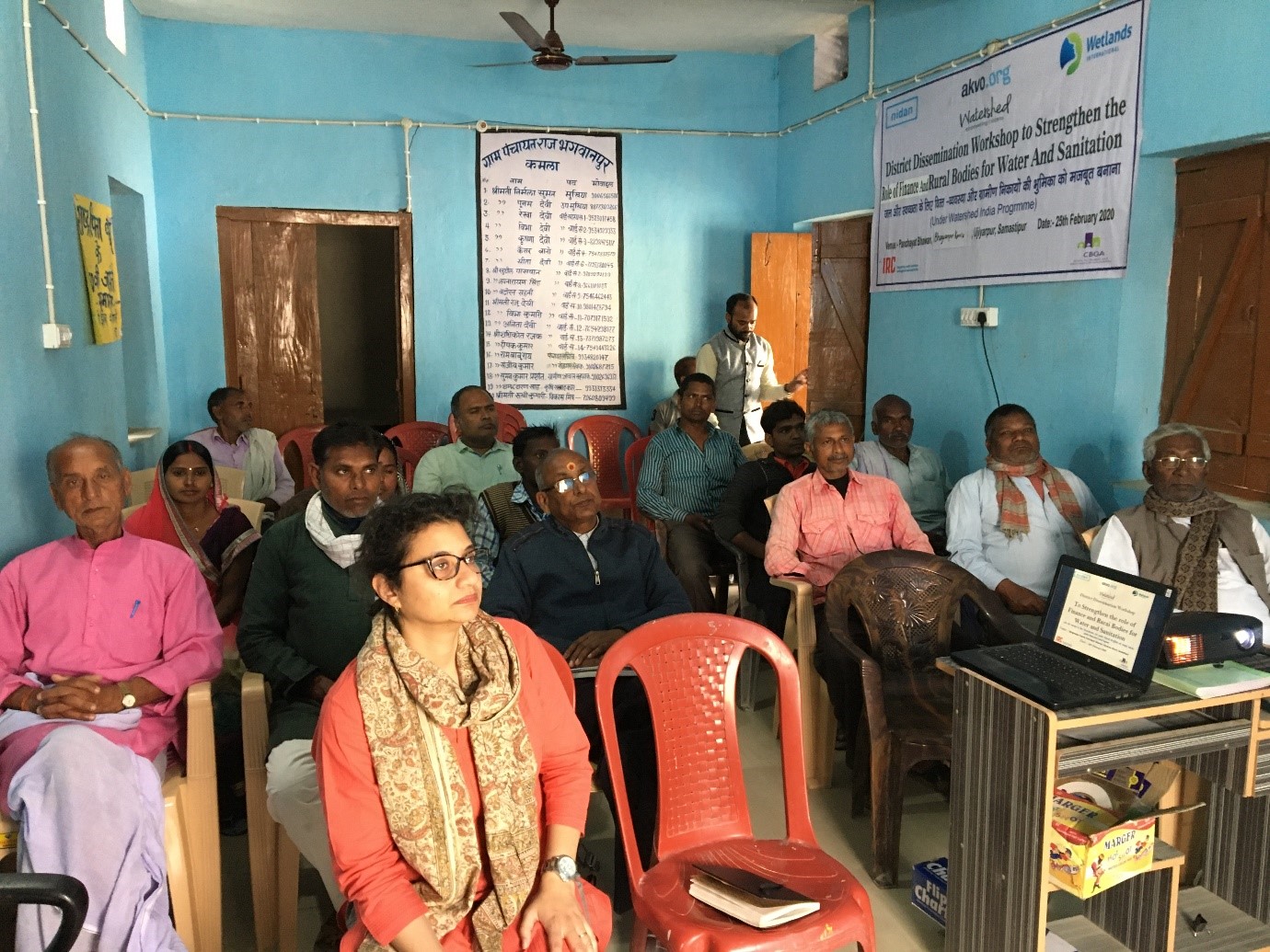Holistic planning is an absolute must to ensure sustainable services. Therefore, for sustainable water and sanitation services, it is important to plan for water supply and toilet construction, as well as water security, and solid and liquid waste management. This was stated by Mr. Suresh Paswan, the District Panchayati Raj Officer of Ujiarpur block, in Samastipur district, Bihar during the district sharing and validation workshop on budget tracking. The workshop, held on 25 February 2020 was organised as part of the Watershed programme, by Nidan (landscape partner in Bihar), Centre for Budget and Governance Accountability (technical partner) and IRC. The workshop saw participation of community members, Ward Implementation and Management Committee (WIMC) members, elected village council representatives, government officials and civil society organisation representatives.
Mr. Paswan’s statement is indeed relevant in the context of Bihar, where the state government has taken strides in holistic planning. In 2016, the government of Bihar, as part of the Chief Minister’s Saat Nishchay or seven resolve programme, launched two schemes – the provision of piped drinking water to every household (Har Ghar Nal ka Jal) , and connecting every household to pucca drainage (Ghar Tak Pakki Gali Naaliyan). Subsequently, in 2019 the state government launched Jal Jeevan Hariyali Abhiyan, a programme focusing on water security through renovation of public water sources (ponds, lakes, reservoirs, etc.), water harvesting and improving agricultural practices. Through these three initiatives – source security, service provision and waste management – the state government has attempted a holistic approach to address sustainability of water services.
The challenge, however, remains in the difference between initiatives on paper and implementation of the same on the ground. These challenges, as was reported in the workshop, stem from lack of information, capacities, transparency, and more. The ensuing discussion at the workshop was useful to bring to the fore some solutions to address the stated challenges, which have been listed below.
- Access and dissemination of information – Key information like government guidelines, updates on changes in procedures, contacts of officials to be made available as much as possible at the Panchayat building.
- Transparency of processes – There needs to be common understanding on the roll out of the schemes, the roles and responsibilities of the different stakeholders, and the support available.
- Transparency of budgets – There are always questions around transparency in schemes related to hardware or construction. It is, thus, very important to make available the cost break-up of the budget or expenditure on such schemes at key public places, like the wall of the Panchayat building. This practice is already being followed by several village councils across the country.
- Coordination between key stakeholders – The Block administration, village council chief, WIMC as well as the line department have important roles to play in the implementation of schemes. It is, therefore, key that those with important roles meet on a regular basis to ensure continuity, quality and timely and coordinated completion of work. In cases of conflict, mechanisms to consult senior authority to solve the conflict should be put in place. This is required in order to get stalled or almost completed works finished to quality standards and get services to all.
- Technical support from line departments – There is need for technical support from the line department through timely inputs at the various stages of planning, tendering, selection of contractor, monitoring the quality of work.
- Regular/ongoing capacity building of village council chiefs and WIMCs – There is a need for regular capacity building to strengthen local institutions. The trainings need to touch upon:
- Planning processes
- Budgets/funds available, how to plan based on budgets, possibility of leveraging other funds – from where, how
- Tendering processes
- Contracting processes
- Monitoring of works
- Support available (technical and administrative)
- Maintaining and transparency of accounts
- For water supply – preparing for tariffs
- Communication to the communities – why, how much, where will it used, how can they track this
- Mechanism of collection of tariffs – who, when, what if not paid
- Maintenance and transparency of accounts of tariffs collected
To ensure that water and sanitation services reach all in a sustainable manner, it is crucial that local governance and management are strengthened – to hold the block administration, the line department accountable as well as be accountable to the citizens that voted it in to power . Platforms like the village meetings are useful platforms for democratic and participatory processes. However, ensuring effective use of such platforms is an equal responsibility of the elected representatives as is that of the citizens.
This article was written by Ruchika Shiva and Shiny Saha (IRC)

